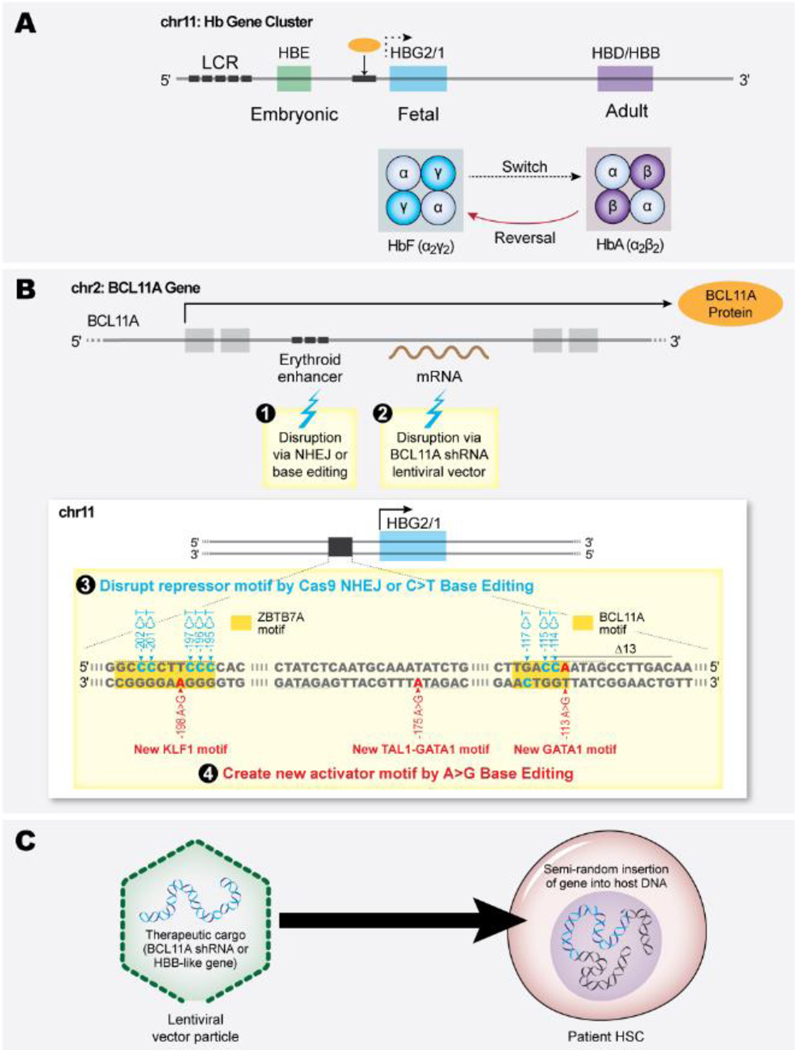Figure 1:
Therapeutic genetic manipulation of sickle cell disease (SCD) patient hematopoietic stem cells (HSCs). (A) The developmentally regulated β-like globin gene cluster. Two fetal γ-globin genes (HBG2 and HBG1 shown here as a single HBG2/1 gene) are expressed during late gestation, resulting in the production of fetal hemoglobin (HbF, α2γ2) in red blood cells (RBCs). Around birth, γ-globin expression declines and is replaced by adult globins, predominantly β-globin (HBB) but also small amounts of δ-globin HBD shown here as a single HBD/B gene), resulting in a shift from HbF to HbA (α2β2) (and small amounts of HbA2 (α2δ2) in healthy individuals, or to HbS (α2βS2) in the case of SCD. The switch from HbF to HbA is highly regulated by BCL11A, a transcription repressor that binds to the HBG2/1 promoters (orange circle represents BCL11A protein, black box underneath represents the HBG2/1 promoters where it binds). Inhibiting the γ- to β-globin switch can alleviate β-hemoglobinopathies. (B) Induction of HbF by interfering with the expression or binding of the transcriptional repressors BCL11A or ZBTB7A to the HBG2/1 promoters (their binding motifs are highlighted in orange in panel 3). Panel 3 shows the γ-globin gene (HBG1 and HBG2) promoter. Around birth, BCL11A expression increases, and the protein binds a cognate motif (TGACC) to inhibit γ-globin transcription. Strategies for manipulation of autologous SCD patient HSCs include disruption of an erythroid-specific BCL11A gene enhancer via genome-editing nuclease–mediated NHEJ or base editing (1), transduction with a lentiviral vector (LV) that drives erythroid-specific expression of a BCL11A shRNA (2), disruption of a BCL11A/ZBTB7A binding motif in the HBG2/1 promoters via NHEJ or C>T base editors (3). Other genetic strategies for HbF induction use base editors to generate naturally occurring hereditary persistence of fetal hemoglobin variants that create new binding motifs for transcriptional activators KLF1 (RCCNCNCCCN), TAL1-GATA1 (CAGNTGNNNNNNNNNWGATAR) or GATA1 (WGATAR) (4). (C) Lentiviral vector gene therapy. SCD HSCs are transduced with lentiviral vector particles encoding erythroid-specific expression cassettes for a β-like globin gene or BCL11A shRNA. The LV integrates semi-randomly into the host HSC genome and is expressed in erythroid progeny. The β-like globin binds endogenous α-globin to generate functional HbA; the shRNA inhibits BCL11A expression to induce γ-globin transcription and raise HbF levels.

